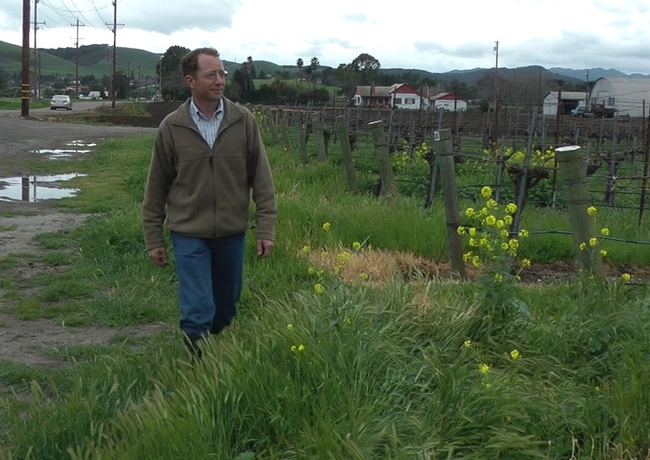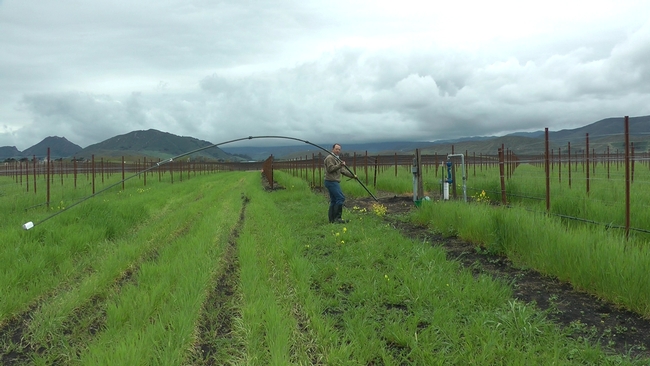Posts Tagged: Mark Battany
Roof-top gardens on LA skyscrapers connect people with food
"Chefs are using what's produced (in the garden) in their kitchens because they know their customers appreciate fresh, local food," said Rachel Surls, the sustainable food systems advisor for UC Cooperative Extension in Los Angeles County.
Surls was part of a recent tour of urban agriculture in downtown Los Angeles, a story that was also covered by the LA Times.
The visitors — who included growers, urban policymakers, consultants, entrepreneurs and representatives of nonprofits — wandered around the vegetable beds and asked questions as they got a taste of the garden. The article said the garden, on the fifth floor of a building at 6th and Figueroa streets, cost about $40,000 to build and yields as much as $150,000 worth of produce every year.
Other news:
Drought clouds future of California wine industry
W. Blake Gray, Wine-searcher-com
The California drought didn't impact the wine industry in 2014, but a dry forecast for next year has growers worried. One major issue is the buildup of salts in soils, said Mark Battany, UC Cooperative farm advisor in San Luis Obispo County. During a wet winter, these salts are washed away. But California hasn't had a wet winter in three years. Farmers were able to irrigate at the beginning of the drought to make up the difference, but increasingly water supplies are restricted.
Battany says that excess salt buildup in the soil can cause grapevines to lose their leaves. "Without a way to process sunlight, you won't see sugar ripening," he said.
Showdown looms as California eyes pesticides
Ellen Knickmeyer, Associated Press
Organic farmers are challenging a proposed California pest-management program they say enshrines a pesticide-heavy approach for decades to come, including compulsory spraying of organic crops at the state's discretion.
The farmers are concerned about the California Department of Food and Agriculture's pest-management plan, the article says. The 500-page document lays out its planned responses to the next wave of fruit flies, weevils, beetles, fungus or blight that threatens crops. Many groups challenging the plan complained that it seems to authorize state agriculture officials to launch pesticide treatments without first carrying out the currently standard separate environmental-impact review.
The article reported that the California organic agriculture industry grew by 54 percent between 2009 and 2012. California leads the nation in organic sales, according to statistics tracked by UC Cooperative Extension specialist Karen Klonsky, who says the state is responsible for roughly one-third of a national organic industry.
'On the road' reporter visits with UC Cooperative Extension advisor
Reporter Cary Blake of Western Farm Press visited with UC Cooperative Extension advisor Mark Battany during a California road trip being chronicled in the magazine's new Farm Press Blog. Battany is a viticulture expert serving San Luis Obispo and Santa Barbara counties.
The topic of his conversation with Blake was water, or more specifically, the lack thereof.
Battany said local groundwater levels in the Paso Robles area continue to decline. He is conducting research as part of a two-state project (California and Washington) to improve water efficiency in wine-grape production.
Farm's experiment with no-till cotton shows promise
Cecelia Parsons, AgAlert
Danny Ramos, the innovative manager of Lucero Farms near Dos Palos, welcomed growers and researchers to view no-till cotton being cultivated at the ranch.
"No one else in California has done no-till cotton on this scale, and done it successfully," said Jeff Mitchell, UC Cooperative Extension specialist in the Department of Plant Sciences at UC Davis.
The crop follows four years of tomatoes and dry farmed wheat that was planted last winter. Without rain, the wheat failed. He decided to shred the plants and plant cotton into the residue.
The no-till field is using less water than an adjacent tilled field, Ramos said.
"With high water costs, no-till is the way to go," he said.
UC study shows promise for protecting coastal winegrapes from frost
In California’s coastal winegrape-growing regions, a spring freeze can be devastating. Tender shoots and leaves burn back, causing damage that reduces the crop yield when it is harvested many months later.
“We’ve had some very severe frosts in San Luis Obispo County and on the Central Coast over the years,” said Mark Battany, UC Cooperative Extension advisor in San Luis Obispo and Santa Barbara counties. “In 2011 we had the most severe frost in 30 years and many millions of dollars of crop and wine value were lost because of that freeze.”
Farmers take various measures to protect their crops when temperatures dip below freezing, such as mowing or tilling the vineyard row middles, or running sprinklers with water pumped from underground aquifers or diverted from streams.
“Sprinkler frost protection is very effective in many areas,” Battany said. “The concern we have in California is that water is becoming more limited. We don’t have the ability to easily import water from other areas to our coastal regions, and our local supplies are being stretched quite thin.”
Some farmers are considering wind machines, which mix warmer air high above the ground with air closer to the ground to raise the temperature. But wind machines are expensive, and the potential effectiveness depends on the strength of the temperature inversion. UC scientists are now gathering data to help inform farmers before making the costly investment.
Battany and his colleagues - Rhonda Smith, UCCE advisor in Sonoma County, Richard Snyder, UCCE specialist in the Department of Land, Air and Water Resources at UC Davis, and Gwen Tindula, UCCE staff research associate - are collecting temperature inversion data at different locations in 60 coastal vineyards throughout three counties to document inversions during frost events.
The scientists installed 35-foot-high meteorological towers with data loggers at the top and at the five-foot height to measure the difference in temperature. In the first year of the study, there were useful inversion conditions on nearly three-fourths of the nights when there was frost.
“That’s a fairly good success rate,” Battany said. “The wind machine will provide quite a bit of protection under those conditions.”
The study will continue this year and in 2014. Farmers who wish to install their own meteorological towers with data loggers can do so at a cost of about $250 each. Installation instructions and specifications are available on the UCCE website.
The UCCE research is funded with a grant from the American Vineyard Foundation and a CDFA Specialty Crops Block Grant.
For more details, see the video below:
UC receives more than $6 million for specialty crop research
University of California researchers will receive more than $6 million in funding from the U.S. Department of Agriculture’s 2011 Specialty Crop Block Grant program, which is intended to enhance agricultural markets, address environmental concerns, protect plant health, provide farmers with scientifically tested production techniques and increase food safety.
The USDA awarded $55 million nationwide for the Specialty Crop Block Grant program, which provides grants to states to enhance the competitiveness of fruits, vegetables, tree nuts, dried fruits, horticulture and nursery crops.
The California Department of Food and Agriculture identified 72 projects in the state for funding, including 30 projects led by University of California agricultural researchers.
“Funding for specialty crop research is critical to California’s $37.5 billion agricultural industry because many of the crops grown in California are considered specialty crops,” said Barbara Allen-Diaz, UC vice president for agriculture and natural resources. “With these funds, UC scientists will be helping California farmers find new ways to protect their crops from pests and diseases, remain economically viable, and provide healthy food for an increasing number of people.”
Highlights include:
- The UC Davis Center for Produce Safety received a combined $1.4 million for food safety projects, many of which will develop strategies to reduce the risk of foodborne illness.
- Assessing temperature conditions to determine the potential for using wind machines as an alternative to sprinklers for frost protection in coastal vineyards with the ultimate goal of reduced water use is the goal of a $59,961 project led by UC Cooperative Extension viticulture advisor Mark Battany in San Luis Obispo County.
- The UC Agricultural Issues Center will be conducting an analysis of the effects of quality control standards and European Union trade policies on the California olive industry, to identify market opportunities as standards and policies change, funded for $135,883.
- The largest single award made to UC in this round was $495,750 to a statewide project that will assess the effects of reduced irrigation on strawberries, blueberries and blackberries -- including berry yield, nutritional content, flavor and consumer preference -- led by researchers with the UC small farm program.
- A project that will train small-scale, Latino, Hmong and Mien growers in Fresno, the Sacramento Valley, the Central Coast and Southern California regions to compete in new markets, led by the UC Sustainable Agriculture Research and Education Program, received $86,851.
- Developing improved integrated pest management strategies that could help ornamental nurseries protect against the light brown apple moth is the goal of a $255,598 project led by Steve Tjosvold, UC Cooperative Extension farm advisor for Santa Cruz County.
“Many of these projects are collaborative efforts between farmers and scientists from UC campuses, UC Cooperative Extension advisors in counties, and other agencies and educational institutions,” Allen-Diaz said. “This array of expertise focused along the spectrum of specialty crops production will help keep California competitive in the global economy.”
For a complete list of California’s Specialty Crop Block Grants projects, please visit http://www.cdfa.ca.gov/grants.

191-1439



